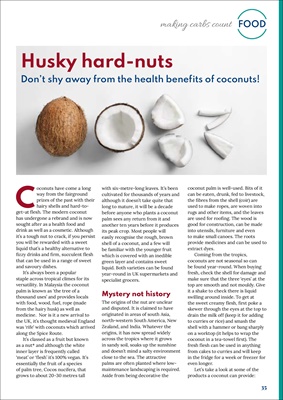
35
FOOD
making carbs count
Husky hard-nuts
Don't shy away from the health benefits of coconuts!
Coconuts have come a long
way from the fairground
prizes of the past with their
hairy shells and hard-toget-at
flesh. The modern coconut
has undergone a rebrand and is now
sought after as a health food and
drink as well as a cosmetic. Although
it's a tough nut to crack, if you persist
you will be rewarded with a sweet
liquid that's a healthy alternative to
fizzy drinks and firm, succulent flesh
that can be used in a range of sweet
and savoury dishes.
It's always been a popular
staple across tropical climes for its
versatility. In Malaysia the coconut
palm is known as 'the tree of a
thousand uses' and provides locals
with food, wood, fuel, rope (made
from the hairy husk) as well as
medicine. Nor is it a new arrival to
the UK, it's thought medieval England
was 'rife' with coconuts which arrived
along the Spice Route.
It's classed as a fruit but known
as a nut* and although the white
inner layer is frequently called
'meat' or 'flesh' it's 100% vegan. It's
essentially the fruit of a species
of palm tree, Cocos nucifera, that
grows to about 20-30 metres tall
with six-metre-long leaves. It's been
cultivated for thousands of years and
although it doesn't take quite that
long to mature, it will be a decade
before anyone who plants a coconut
palm sees any return from it and
another ten years before it produces
its peak crop. Most people will
easily recognise the rough, brown
shell of a coconut, and a few will
be familiar with the younger fruit
which is covered with an inedible
green layer and contains sweet
liquid. Both varieties can be found
year-round in UK supermarkets and
specialist grocers.
Mystery not history
The origins of the nut are unclear
and disputed. It is claimed to have
originated in areas of south Asia,
north-western South America, New
Zealand, and India. Whatever the
origins, it has now spread widely
across the tropics where it grows
in sandy soil, soaks up the sunshine
and doesn't mind a salty environment
close to the sea. The attractive
palms are often planted where lowmaintenance
landscaping is required.
Aside from being decorative the
coconut palm is well-used. Bits of it
can be eaten, drunk, fed to livestock,
the fibres from the shell (coir) are
used to make ropes, are woven into
rugs and other items, and the leaves
are used for roofing. The wood is
good for construction, can be made
into utensils, furniture and even
to make small canoes. The roots
provide medicines and can be used to
extract dyes.
Coming from the tropics,
coconuts are not seasonal so can
be found year-round. When buying
fresh, check the shell for damage and
make sure that the three 'eyes' at the
top are smooth and not mouldy. Give
it a shake to check there is liquid
swilling around inside. To get at
the sweet creamy flesh, first poke a
skewer through the eyes at the top to
drain the milk off (keep it for adding
to curries or rice) and smash the
shell with a hammer or bang sharply
on a worktop (it helps to wrap the
coconut in a tea-towel first). The
fresh flesh can be used in anything
from cakes to curries and will keep
in the fridge for a week or freezer for
even longer.
Let's take a look at some of the
products a coconut can provide: